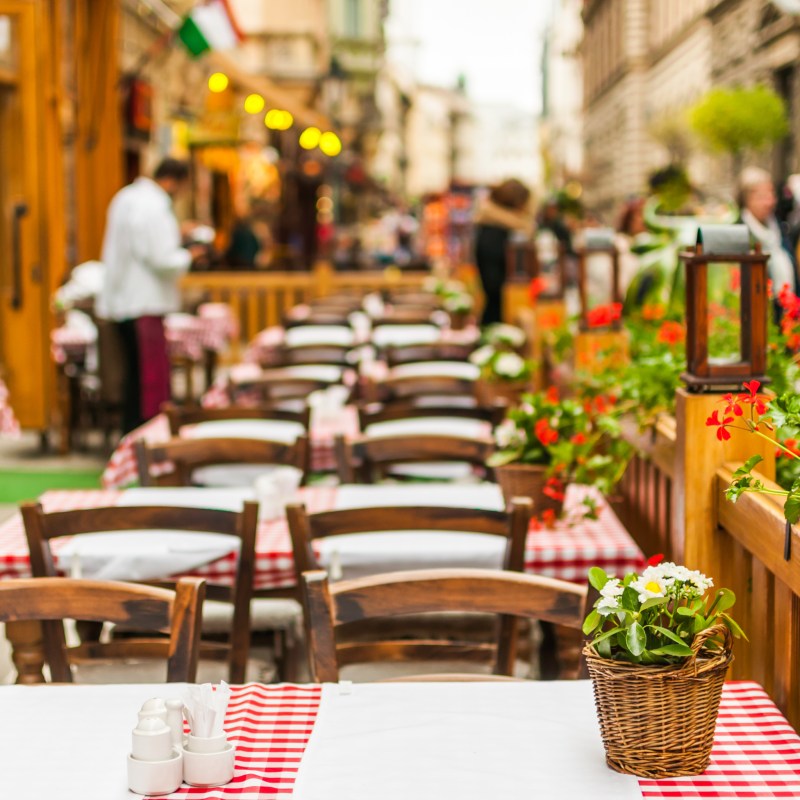
Food isn’t just sustenance. When traveling, it’s about authenticity, culture, and experience. It’s how we truly taste a place. So I won’t duck into the nearest restaurant when I’m hungry. Instead, I have a game plan based on the dishes, produce, and restaurants my destination is famous for.
Videos by TravelAwaits
Here’s my curated list of tips that help me find the best food in any town.

Nadine Cresswell-Myatt
1. Move Away From Tourist Attractions
If a restaurant is even in the shadow of a tourist attraction, stay away. The prices will be heftier and the food less appetizing. Even moving a block or two away down a side street improves your options.
An example: Melbourne’s Lygon Street, Carlton, is a mecca for tourists due to its rich Italian culture. The result is spruikers standing outside the alfresco cafes luring tourists in for expensive meals.
Locals love this strip for the vibrancy but duck into hole-in-wall places like Tiamo/Tiamo2 (40 years of authentic, cheap Italian food). No spruikers needed because of low prices and great food.
2. Apply The Two-Block Rule
Restaurant critic Terry Durack has a travel hack called the two-block rule which I now follow. Every city has its food precincts, such as the Mission District in San Francisco or Soho in London.
Book your hotel slap in the middle of a food precinct. Now you only have to move in a two-block radius to find great coffee, a food store, restaurants, and a wine shop. I did this when staying in New York’s East Village. I was surrounded by multicultural eateries — Filipino, Korean, Ukrainian, Taiwanese. There were craft beer and oyster bars, and dishes like Oiji’s chips with melted butter, sugar, and cayenne. At Raclette, I experienced Alpine cheeses melted on the hot wheel and then draped over potatoes, roasted garlic, cornichons, and pickled white pearl onions.
Pro Tip: Pick an area where there is a dedicated food tour — it demonstrates the district has a strong food culture.
3. Use Facebook As A Sounding Board
A few of my friends are either Irish or keen travelers. I asked for their recommendations on Facebook before visiting Dublin. Tips came in thick and fast.
“Try the boxty (potato pancakes) at Gallagher’s Boxty House,” “Can’t go past a roasted loin of Limerick bacon with cabbage,” and, “Even if you don’t like Guinness, go to the bar at the top of the Guinness Storehouse for the view,” were among the tips I received.
To Set Up:
- Click “What’s on your mind?” at the top of your News Feed
- Scroll down and click “Ask for Recommendations”
- Select the city where you’re looking for recommendations
- Facebook creates a map for you
4. Hit Up Facebook Groups
Join a food-related Facebook group. When I visited my daughter in Salt Lake City she was surprised my name was already on Gastronomic SLC Food Talk.
“Of course! I wanted ideas on where to take you for dinner,” I said. We ate out lots. At Red Iguana, the most awarded Mexican restaurant in town. Ruth’s Diner for killer breakfasts. And Eva’s Bakery for French toast stuffed with lemon cream cheese.
Pro Tip: Google the name of the town plus terms like “food lovers” or “foodies.” Post questions like “What’s the best restaurant for patio dining?” or “Where’s the best poke bowl?”

Nadine Cresswell-Myatt
5. Know Your Food
Knowing the names of local dishes is vital in tracking them down. In Indonesia, you can then ask, “Where can I try Gudeg?” (steamed jackfruit with coconut milk, palm sugar, lemongrass). If you can’t pronounce the name of the dish, write it down (or print it out) to show locals. I chased down funeral potatoes in Utah. These are hard to find as they’re generally a dish made by home cooks and served at wakes. But asking around led me to Garage on Beck, a roadhouse with a Mad Max dystopian vibe. Sometimes the oddest eating spots are the most memorable.
6. Pay It Forward
When you find an eatery you enjoy, ask another customer where else they like to eat. There’s a fair chance they have similar tastes to you and can offer targeted suggestions. I enjoyed The Crumpet Shop at Seattle’s Pike Place Market. A local was seated near me and we discussed Pike Place Chowder, where tourists wait up to an hour to place a soup order. He told me of a superior option without the crowds, where I could not only sit but also have Alaskan razor clam chowder finished with a drizzle of truffle oil. Nice conversation. Dinner sorted.

Nadine Cresswell-Myatt
7. Trust Bloggers
Successful local food bloggers know all the best food haunts in town.
I write for one of my city’s local event websites, which means attending media launches. In this role, I meet lots of young food bloggers. Most have day jobs but are out five nights a week on invites snapping food photos.
They build up a huge bank of local food knowledge, which is why I trust their opinions. They write about “people’s foods” and not always the most expensive restaurants in town. The type you eat while traveling except for the occasional special meal out.
Bloggers meals are often gifted. But restaurateurs rarely invite bloggers unless they have exceptional food.
Pro Tip: Search “food blogger” plus the name of the city. For special meals keep an eye out for food critics based in that city.
8. Foodstagram
Instagram has outstripped TripAdvisor as the main way people find new places to eat. As the saying goes, we eat with our eyes. Okay, some of those toppling burgers are visual trickery or the antics of bored chefs. But images confirm whether the food is creative and well plated. Around 69 percent of millennials photograph their food before eating, so there’s a wealth of visual information. Before ordering you can look up the most Instagrammed dishes. These are likely to be the most popular. If you see an individual’s Instagram account has tens of thousands of followers, they’re an influencer and have likely been paid to post. But when a restaurant’s dishes are attracting heaps of photos, it shows the public is snapping up this venue.

Nadine Cresswell-Myatt
9. Vloggers Show All
I’ve discovered watching vloggers on YouTube is the best way to gain an overview of a city’s food. It is like meeting foodies in person. They mention how long they have lived in their town and their food tastes. I press pause on some who strain too hard to be personable but others are naturals. The kind of people I would love to chat with about food. They eat in front of you so you see their looks of rapture or pain. They take you inside venues so you can see for yourself. Vloggers don’t make a name for themselves unless they unearth local gems. So they scout out less touristy places. Here’s an example of vloggers I watched to get a handle on Seattle’s food scene.
Pro Tip: Search “Vlogger + name of city + food” on YouTube.
10. Join That Queue
Read queues outside restaurants, food vans, or street vendors as signposts to great food. I was so amazed by a queue for Pastel de nata (Portuguese tarts) at a Portuguese Festival I attended. They ran out well before I reached the head of the queue. When I saw how crestfallen everyone was, sourcing that tart became a food goal. I found one a few weeks later. Once my teeth sank into that pillow of deliciousness, I could taste what all the hype was about.

Nadine Cresswell-Myatt
11. Take Free Walking Tours
Most cities run free walking tours. Guides are often students making rent. Ask them where they eat. In Oxford, UK, I used this ploy and ended up in Turl Street Kitchen, a social enterprise staffed by students. The food was high quality, locally sourced, and delicious. I loved sitting down to fluffy bubble and squeak, salads with watercress, and English steamed puddings.
12. Check Out Airbnb
Seattle is an expensive town. My Airbnb host recommended I eat at Dough Zone. Once I’d tried those Xiaolongbao (soup dumplings) and paid the meager bill, it confirmed why the host’s tips are priceless. Even if not staying in an Airbnb you can access such tips. Airbnb collates the host’s recommendations on their city-specific “Things to Do” pages. Here’s an example.
Pro Tip: You won’t find this option on the main Airbnb page. Instead Google “Airbnb + restaurants + city name.” Only major cities have these dedicated pages.

Nadine Cresswell-Myatt
13. Ask Hotel Staff
Some concierges claim a gratuity if they book your table reservation, so they have a vested interest in sending you to a tourist restaurant. Which is why I tend to ask other hotel staff. It is best to ask for something specific and off-the-radar. A friend told me about her experience.
“I was in Boston and I asked a girl at the hotel check-in for the name of a close-by, inexpensive Mexican restaurant. She sent me to the one she goes to, down an obscure lane-way. I would never have found it on my own. It was absolutely fabulous — authentic and colorful with lovely food, and it didn’t even appear on TripAdvisor.”
Pro Tip: Industry pros like waitstaff and bartenders know where all the good stuff is. Ask where they eat.
14. Check Review Sites
But don’t let them make your dining decisions for you. Yes, most of us use TripAdvisor and Yelp. But as Rick Steves writes: “I have serious doubts about TripAdvisor’s restaurant rankings, which reflect the tastes of tourist reviewers rather than local foodies — and therefore skew toward glitzy, obvious places rather than good-value, authentic, hidden alternatives.”
Plus, in a world of fake reviews, it’s hard to unearth the truth. I took a quiz on spotting fake reviews and failed. I’m also concerned the top 10 get recommendations get there by paid placements. Not by you and I writing honest reviews. So, I use these sites in my research but no longer take them as gospel.
Pro Tip: Check the top 10 recommendations in your own city. Do you agree with those suggestions? If not, then don’t trust the site you’re checking when you are traveling elsewhere. Try leveraging some of these other tips instead!
